Creating Analytics-Fueled Content Plans
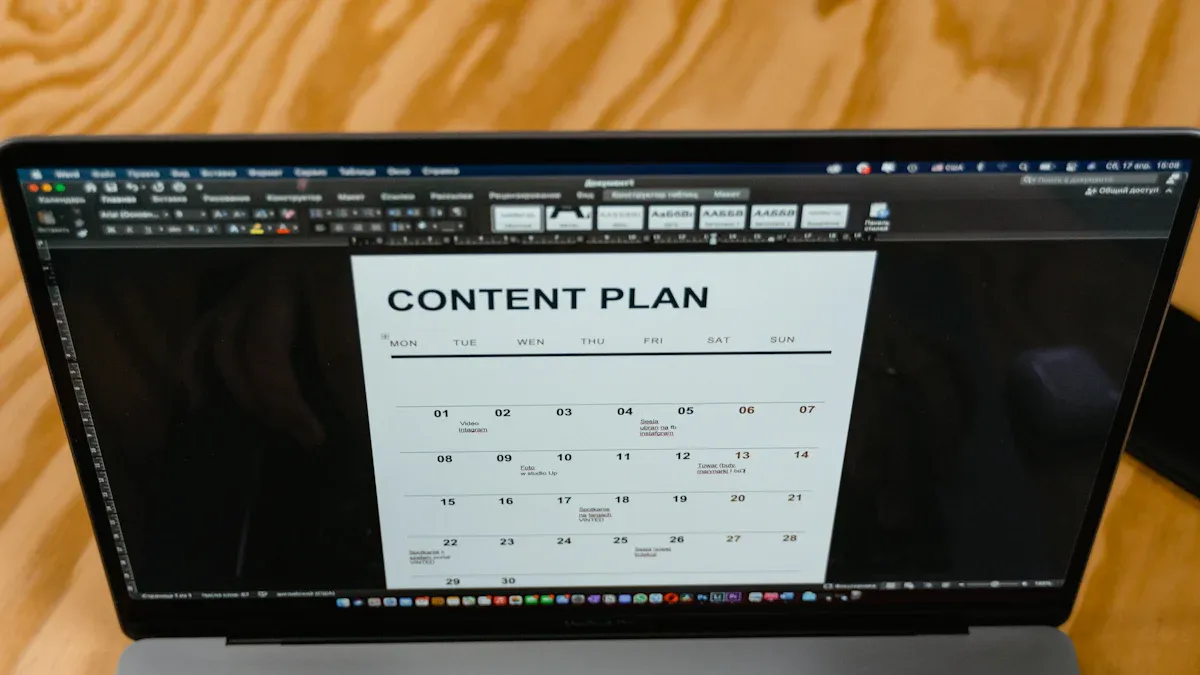
You can use analytics to help you make better choices in content planning. When you use data and AI, your plan gets smarter and works better. Many companies get 30-40% more ROI and 50% more customer engagement when they use data-led tactics. The table below shows more ways analytics can help:
Statistic Category | Numerical Evidence | Explanation |
|---|---|---|
ROI Improvement | 30-40% increase in ROI | Companies using data-led tactics get better returns than old ways. |
Customer Engagement | 50% increase | Data-driven segmentation makes more targeted content, so engagement goes up. |
Predictive Analytics Impact | Use of ARIMA and models | Forecasting trends helps you plan content that fits better. |
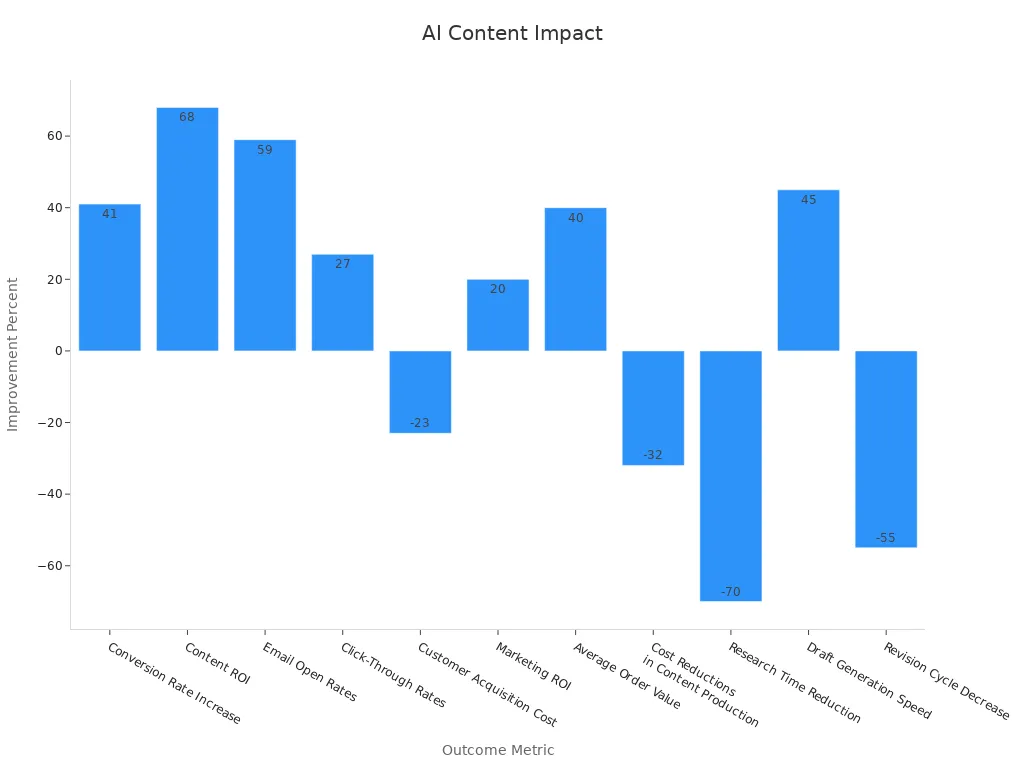
Analytics-Fueled Content Plans help you fix problems like low engagement or wasted work. You can start to see how your own results could get better.
Key Takeaways
Let data and AI help you pick what content to make. Do not guess what will work. Set clear goals for your content. Know who your audience is. This helps you make content that connects with people. Watch important numbers like traffic, engagement, and conversions. This shows you what works best. Choose topics and keywords from real trends. Use analytics tools to see what your audience likes. Keep making your content better. Check your results often. Update your plan quickly when you need to.
What Are Analytics-Fueled Content Plans
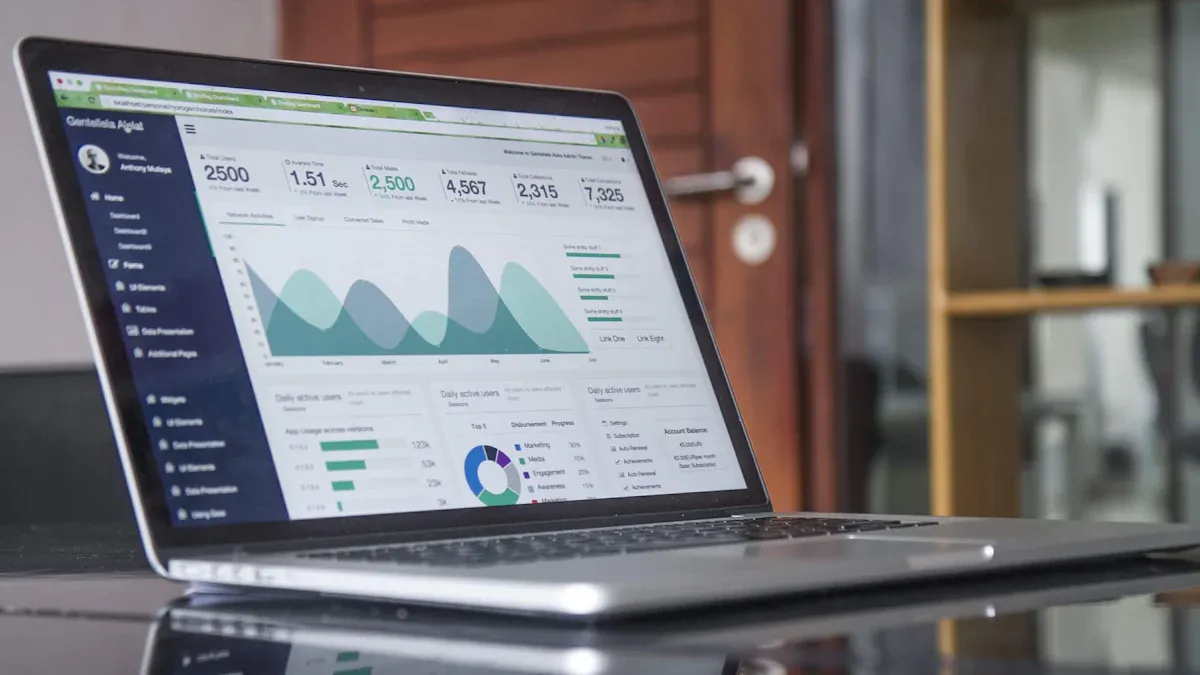
Data-Driven Approach
You can build stronger content strategies when you use data as your guide. Analytics-Fueled Content Plans rely on facts, not guesses. You look at what your audience likes, how they behave, and what trends shape their choices. This approach helps you create content that matches real needs.
Many top companies use this method. For example:
Netflix wanted to keep more subscribers. They studied what people watched, searched for, and rated. They used tools like AWS Redshift and Apache Kafka to collect and stream data. Machine learning models, such as TensorFlow and PyTorch, helped them predict what viewers would enjoy. Netflix then made original shows based on these insights. As a result, they kept more subscribers and grew their audience.
Spotify also uses a data-driven approach. They track what songs you play, skip, or save. Spotify creates playlists like "Discover Weekly" by analyzing your habits. They spot gaps in their music and podcasts, then add new content to fill those gaps. This keeps users happy and encourages more people to subscribe.
You can see how Analytics-Fueled Content Plans help companies stay ahead. They use real data to make smart choices.
Why Analytics Matter
Analytics give you a clear picture of what works and what does not. You can spot patterns in user behavior and adjust your plan quickly. This means you waste less time on content that does not connect with your audience.
With Analytics-Fueled Content Plans, you can:
Find out which topics get the most attention.
See which formats your audience prefers.
Measure how well your content performs over time.
Tip: Use analytics to test new ideas. If something works, do more of it. If not, change your approach fast.
Analytics help you make every piece of content count. You move from guessing to knowing, which leads to better results.
Setting Goals and Audience
Defining Objectives
You need clear goals before you start planning your content. Setting specific, measurable, attainable, relevant, and time-bound (SMART) objectives helps you know what you want to achieve. For example, you might set a goal to increase website traffic by 20% in the next three months or boost sales by 15% in the next quarter. These targets give you a way to measure your progress.
When you set clear goals, you make it easier to track your results. You can use numbers like conversion rates, click-through rates, and ROI to see if your content works. For instance, you might want to raise your paid search sales conversion rate by 15% in Q1. This kind of goal is easy to check and helps you stay focused.
Most successful content marketers have a documented strategy. In fact, 65% of top performers write down their goals, while only 14% of the least successful do this. When you document your strategy, you keep your team focused and use your resources better. You also make sure your content matches your business and customer needs.
Tip: Write down your goals and check your progress often. This keeps your content plan on track and helps you make smart changes.
Identifying Buyer Personas
Knowing your audience is key to making content that works. You should create buyer personas, which are profiles of your ideal customers based on real data and research. Start by looking at your current customers. Gather information about their age, gender, income, education, and what they like or dislike.
You can use these steps to build strong personas:
Collect data from your customers, such as demographics and behaviors.
Use surveys, interviews, or focus groups to learn about their needs and choices.
Add insights from sales data, market trends, and customer feedback.
Test your personas by using them in your marketing and checking engagement.
Start with three or four main personas, then adjust as you learn more.
Behavioral data is just as important as demographics. Watch how people interact with your website, what they buy, and how they search for information. Tools like Google Analytics help you see real actions, not just guesses. You can also spot what your customers want, such as comparing prices or looking for information.
When you combine demographic and behavioral data, you can make content that speaks directly to your audience. You can even create negative personas to avoid targeting people who are not a good fit. This focus helps you use your time and budget wisely, reaching the people who matter most.
Data Collection
Getting the right data is very important for a good content plan. You must know what to measure and which tools to pick. This helps you make better choices and saves you time.
Key Metrics
You need to watch key performance indicators (KPIs) to see if your plan works. These numbers show if your content reaches and interests your audience. They also help you find what needs to get better.
Some important things to track are:
Views
Traffic Sources
Keyword Ranking
Impressions
Click Through Rate
Engagement Rates
Average Engagement Time
Bounce Rate
Conversion Rate or Key Event
Backlinks
Content Shares
Lead Generation
Brand Mentions
Follower or Subscriber Growth
Email Engagement Metrics
Content Marketing Return On Investment (ROI)
You can use these numbers to check success at every step. Impressions and website traffic show how many people see your content. Engagement rates and time on page tell you if people like it. Conversion rates and sales revenue show if your content brings real results.
Tip: Check your KPIs often. This helps you see trends and fix problems before they get big.
A simple table can help you keep your metrics organized:
KPI Measure | Target | Data Source | Reporting Frequency | Owner |
|---|---|---|---|---|
Keywords in top 10 search results | 20 high-intent keywords | SEM Rush data | Weekly | SEO Manager |
Blog articles published | 4 per month | CMS | Monthly | Content Marketing Manager |
E-books published | 2 per quarter | Content management system | Quarterly | Head of Marketing |
When you track these numbers, you can see what is working and what is not. Analytics-Fueled Content Plans use this data to guide each step.
Analytics Tools
You need good tools to collect and understand your data. Google Analytics is a popular tool. It tracks website visits, what users do, and where they come from. You can see which pages get the most views and where visitors start.
AI-driven platforms like AndyAnalytics and IBM Watson Analytics do even more. These tools collect data from many places without much work from you. They help you avoid mistakes and save time. AI tools also give you updates right away, so you can act fast.
Some good things about analytics tools are:
They collect data from websites, social media, and emails automatically
Real-time dashboards show what is happening right now
Predictive analytics help you plan for what is coming
Charts and graphs make it easy to share what you learn
AI-powered tools can use natural language processing to find insights from customer feedback and social media. This helps you know what your audience thinks and feels. Interactive visualizations in tools like Tableau help you look at your data and spot patterns.
Note: Real-time analytics and predictive analytics help you change your content plan quickly. You can see trends early and make changes before others do.
With the right tools, you spend less time gathering data and more time using it. This makes your Analytics-Fueled Content Plans smarter and work better.
Content Ideas and Calendar

Topic Selection
Analytics and AI can help you pick the best topics. These tools show what your audience likes and what your rivals do. You do not have to guess anymore. You can check data from your website, social media, and search trends. This helps you find patterns. AI platforms suggest topics based on what is popular and what people search for most.
Stick Shift Driving Academy used MarketMuse, an AI tool, to get content ideas. The AI made briefs for writers and took away the guessing. This helped the academy choose the right topics. They saw a 72% rise in organic traffic, a 110% jump in form fills, and a 120% increase in calls. This proves that AI and analytics help you pick topics that get real results.
Big stores like Amazon and Walmart use AI to choose topics too. They start with small projects and check the results. Then they do more of what works. This helps them focus on topics that matter to their business and customers.
You can use topical maps to sort your ideas. A topical map puts related subjects together. This helps you cover every part of a topic and become an expert. AI tools can help you make these maps by finding missing topics in your content.
Tip: Use trending topics and search data to keep your content new and useful. AI can tell you when a new trend starts, so you can act fast.
A table can help you compare topic selection tools:
Tool Name | Main Feature | Benefit |
|---|---|---|
MarketMuse | AI-generated topic briefs | Removes guesswork, boosts traffic |
BrightEdge | Expands keywords into topic clusters | Improves topical authority |
Google Trends | Shows trending search topics | Keeps content timely and relevant |
Keyword Research
Strong keywords help people find your content online. Analytics and AI make keyword research quick and correct. You can use tools to see what words your audience uses to search. These tools show which keywords are popular and not too hard to rank for.
Companies that use data-driven SEO get more traffic and engagement. For example, an online store used AI to guide its content plan. This brought more visitors and more sales. Another company found missing topics and matched content to what users wanted. This helped them get more views and user interest. A phone repair service used high-impact keywords and got 573% more blog traffic.
Data-driven keyword research lets you:
Find keywords that match what your audience wants.
Pick keywords with lots of searches and little competition.
Track how your keywords do over time.
Change your plan based on what works.
Note: Track things like organic traffic, bounce rate, and conversions. This helps you see if your keyword choices work. You can use this data to make your content better and stay ahead.
AI tools like BrightEdge can grow your keyword list by 100 times and group them into clusters. This helps you cover every part of a topic and become an expert. Rocky Brands used BrightEdge to find and focus on the best SEO keywords. This helped them earn more from organic search.
Content Calendar
A content calendar helps you plan and organize your posts. You can use analytics to decide when and what to share. This keeps your team working together and makes sure your content meets your goals.
Update your calendar often to match market trends. Sharing the calendar helps your team stay on the same page. You can plan new types of content, like videos or interactive posts, to get more engagement. AI and automation tools can help you guess what topics will be popular and when to post them.
A content calendar lets you:
Plan for what your audience needs and market changes.
Schedule posts for the best times.
Add user-made content to build a community.
Track key numbers like engagement, reach, and conversions.
Tip: Use tools like Hootsuite, Buffer, Trello, or Asana to manage your calendar. These tools let you schedule posts, track how they do, and change your plan fast.
You can use a simple table to track your content schedule:
Date | Topic | Format | Channel | Owner | Status |
|---|---|---|---|---|---|
06/10/2024 | Summer Safety Tips | Blog Post | Website | Alex | Scheduled |
06/12/2024 | Product Demo Video | Video | YouTube | Jamie | In Review |
06/15/2024 | Customer Story | Social | Taylor | Draft |
Scheduling your content with analytics helps you stay organized and work better. You can use A/B testing to see which posts do best. Adding user-made content can make your brand feel real and trusted. Analytics-Fueled Content Plans use calendars to keep your plan focused and flexible.
Optimization and Feedback
Repurposing Content
You can get more out of your content by reusing it. This means you take one piece and change it into new types or update it for other places. Analytics show which posts do well and which need help. For example, you can turn a blog post into a LinkedIn article, a webinar, or a video. Doing this helps you reach more people and get more engagement.
The Search Engine Rewind Report started as a blog post. It got over 48,000 impressions and 232 clicks. When shared on LinkedIn, it had 4,400 impressions and 1,450 clicks. As a webinar, the same content reached 7,000 viewers.
Updating old blog posts with new facts or putting them together can help you get better rankings and stay important.
Changing your message for each platform, like using hashtags on TikTok or different words for LinkedIn, can help you reach more people.
A table shows how these strategies can make results better:
Content Repurposing Strategy | Description | Validated Performance Improvements | Source/Metric |
|---|---|---|---|
Format Transformation | Turning blog articles into videos | HubSpot, 2023 | |
Channel Adaptation | Changing content for different platforms | 135% more reach | CoSchedule, 2022 |
Temporal Recycling | Updating and sharing old content again | 106% average increase in organic traffic | Orbit Media, 2023 |
Economic Efficiency | Repurposing costs 15-25% of the original cost | Up to 60% cost savings | Content Marketing Institute, 2023 |
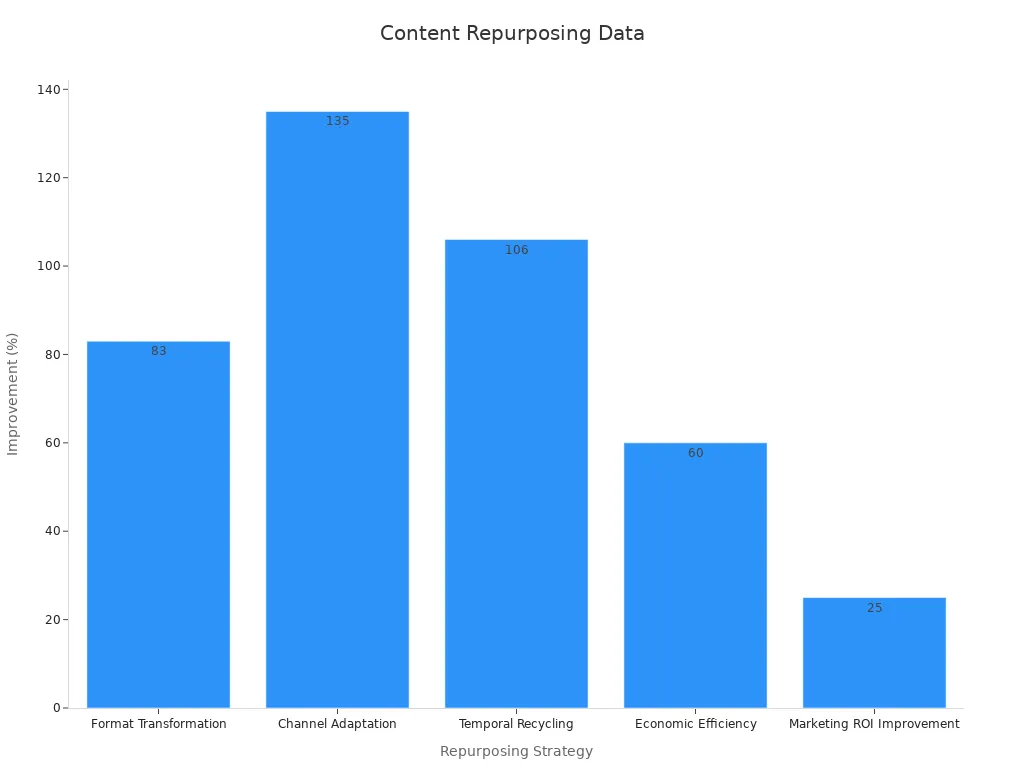
Tip: Use analytics to find which content to reuse. Focus on posts with lots of views or ones that did well before.
Continuous Improvement
You can make your content better by using feedback all the time. Analytics let you see what works and what does not. When you collect data over time, you spot patterns and can make smart changes. Many businesses that track often make better choices 70% of the time. If you check your data every month, you can change your plan 44% faster than if you wait a year.
Watching results for a long time helps you see what needs fixing and what works.
Checking how posts do can make your team work 23% better and make customers 20% happier.
Netflix uses these ideas to keep 80% of its subscribers every year.
AI tools help you look at feedback fast. They show you which topics or types need updates. You can use this to try new ideas and keep your content fresh.
Note: Continuous improvement means you always keep learning. Use analytics to help with every update and keep your content plan strong.
Analytics-Fueled Content Plans in Action
When you use Analytics-Fueled Content Plans, you see results right away. You can track important numbers like cost per acquisition, average order value, and engagement rates. Tools like Google Analytics, SEMrush, and Hootsuite give you live dashboards and alerts. This helps you make quick changes and keep your plan working.
Metric Category | |
|---|---|
Engagement Metrics | Average time on page, bounce rate, scroll depth, social shares, comments |
Conversion Tracking | Lead generation, sales influenced, click-through rates, ROI, customer acquisition cost |
SEO Performance | Organic traffic, keyword rankings, backlinks, CTR on search results, featured snippets |
Retention Metrics | Returning visitors, subscriber growth, time between visits, churn rate |
Social Media Metrics | Likes, shares, comments, reach, impressions, traffic, brand mentions |
Tools & Technologies | Google Analytics, Google Search Console, social media analytics, SEO tools, marketing automation |
Advanced Analytics | AI-powered analytics, machine learning for engagement scoring and predictive content performance |
Monitoring & Action | Real-time dashboards, automated alerts, unified platforms for optimization |
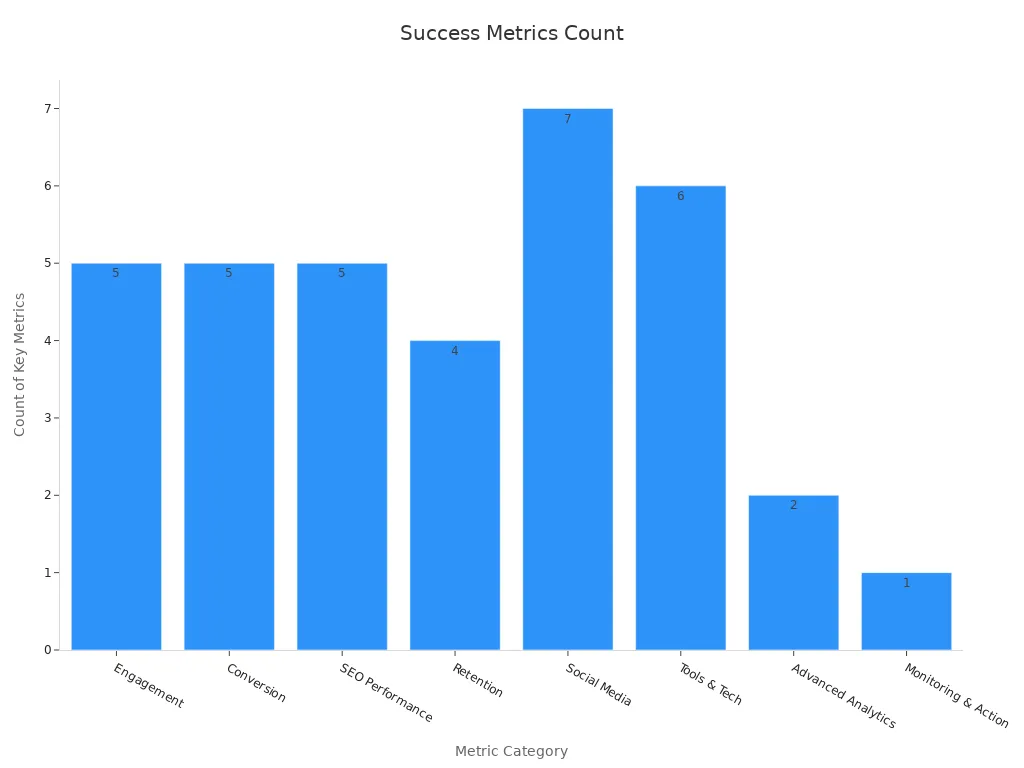
Tip: Set clear goals and use real-time data to change your plan. This keeps your content plan working well and up to date.
When you use analytics and AI, you get a big advantage. Data-driven strategies help you count visitors, engagement, and sales. Marketers who use data often see better ROI. About 26% say they get higher returns. You can see what works and change things fast. This helps you show your work’s value. You can make your content better and waste less money. This way, you stay ahead as things change. Try these steps to stop guessing and make smarter content plans.
FAQ
What is an analytics-fueled content plan?
You use data and AI to guide your content choices. This plan helps you pick topics, track results, and improve your work. You stop guessing and start making smart decisions.
How often should you check your analytics?
You should check your analytics at least once a week. This helps you spot trends early. You can fix problems fast and keep your content plan on track.
Which tools work best for content analytics?
You can use tools like Google Analytics, SEMrush, and AndyAnalytics. These tools track website visits, keyword rankings, and engagement. AI-powered platforms give you real-time updates and predictions.
Can you use analytics for social media content?
Yes! Analytics show you which posts get the most likes, shares, and comments. You can see what your audience enjoys. This helps you plan better posts and grow your followers.
See Also
How To Strategically Plan Your Blog Content Effectively
Complete Handbook For Achieving SaaS Content Marketing Goals
Learn To Excel As A Content Marketing Strategist In 2024
Winning Content Analysis Techniques To Beat Your Competitors

